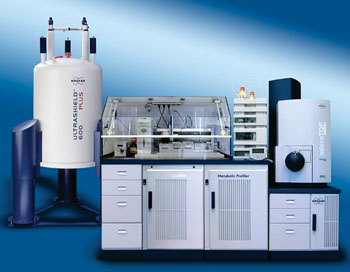Protein Particle Parameters Help Differentiate Acute Kawasaki Disease
By LabMedica International staff writers
Posted on 28 Sep 2016
Kawasaki disease (KD) is a self-limited vasculitis that typically presents in young children as an acute illness with fever and mucocutaneous changes. If KD is incorrectly diagnosed or left untreated, coronary artery aneurysms (CAA) may develop, predisposing KD patients to long-term cardiovascular complications including myocardial ischemia and infarction.Posted on 28 Sep 2016
Glycosylation patterns of serum proteins, such as α1-acid glycoprotein, are modified during an acute phase reaction. The response of acute KD patients to intravenous immunoglobulin (IVIG) treatment has been linked to sialic acid levels on native IgG, suggesting that protein glycosylation patterns vary during the immune response in acute KD.

Image: The metabolic profiler system based on nuclear magnetic resonance (NMR) and mass spectrometry (MS) (Photo courtesy of Bruker BioSpin).
Scientists at Rady Children’s Hospital (San Diego, CA, USA) and their colleagues enrolled 75 children diagnosed with KD according to established criteria and treated at Rady Children’s Hospital between November 2005 and June 2011. Forty-eight age-similar, healthy children undergoing minor orthopedic surgical procedures and 48 febrile children with acute illnesses of viral or bacterial origin were also included in the study as healthy or febrile controls.
White blood cell count (WBC), absolute neutrophil count (ANC), percent polymorphonuclear cells (PMN), high sensitivity C-reactive protein (CRP), and erythrocyte sedimentation rate (ESR) were measured as part of clinical care. Nuclear magnetic resonance (NMR) spectra were acquired from EDTA plasma for the NMR LipoProfile (lipoprotein particle) test at LipoScience (now LabCorp, Raleigh, NC, USA). The NMR Profiler platform is comprised of a 9.4T (400 MHz 1H frequency) spectrometer (Bruker Biospin, Fremont, CA, USA) with an integrated fluidics sample delivery system.
GlycA, a marker of protein glycosylation, was elevated in acute KD subjects compared to febrile controls with bacterial or viral infections, IVIG-treated subacute and convalescent KD subjects, and healthy children. Acute KD subjects had increased total and small low density lipoprotein particle numbers (LDL-P) (and decreased total high density lipoprotein particle number (HDL-P) compared to febrile controls. Consequently, the ratio of LDL-P to HDL-P was higher in acute KD subjects than all groups tested. While GlycA, CRP, ESR, LDL-P and LDL-P/HDL-P ratio were able to distinguish patients with KD from those with other febrile illnesses, the combinations of GlycA and LDL-P or GlycA and the LDL-P/HDL-P ratio were best at discerning KD in patients 6 to 10 days after illness onset.
The authors concluded that high levels of GlycA confirm enhanced protein glycosylation as part of the acute phase response in KD patients. When combined with common laboratory tests and clinical characteristics, GlycA and NMR-measured lipoprotein particle parameters may be useful for distinguishing acute KD from bacterial or viral illnesses in pediatric patients. The study was published on September 5, 2016, in the journal BMC Pediatrics.
Related Links:
Rady Children’s Hospital
LabCorp
Bruker Biospin












.jpg)
